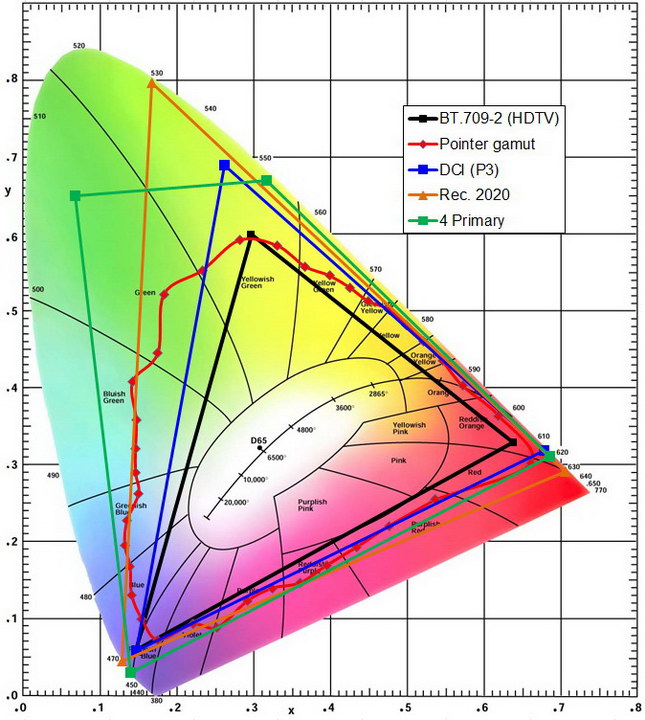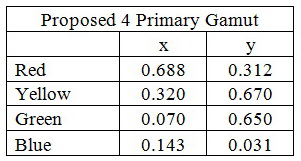One of the little secrets of the display, television and cinema industries is the “Red, Green, Blue” primary colors – aren’t. Red isn’t “Red,” it’s reddish-orange. More importantly, green isn’t “Green,” it’s yellowish-green. Only blue is what a color specialist would call “Blue.”

All color specifications for electronic entertainment have used a three color primary display as the target display for the system. This is true of both the analog systems NTSC, PAL, SECAM and SMPTE 240M (SMPTE “C”), and digital standards such as Rec. 709, sRGB, Adobe RGB, SMPTE P3 (DCI) and Rec. 2020 (UHD-TV). The green primary color specified for each of these standards is not actually “Green,” it is yellowish green. This represents a major problem for the future of wide color gamut (WCG) content.
This issue is not solvable in a color gamut defined by three primary colors and no improvement in color gamut size for three color gamuts is possible beyond what is defined by Rec. 2020. The Rec. 2020 primaries are already on the border of the CIE 1931 color gamut and the green and blue can only be properly reproduced using laser light sources. Not laser/phosphor but blue and green lasers. Blue lasers are fairly straightforward, efficient and affordable using GaN technology. Green lasers are an issue, however. First, they are expensive. Second, the narrow band green laser needed to produce a Rec. 2020 “green” will produce speckle, unless the system designer is very careful.
Due to the physics and human factors of the CIE 1931 color gamut, the Rec. 2020 red can be produced by a relatively broad-band primary, such as one from an LED, whether or not the LED is enhanced by quantum dots. Even proper filtering of white light sources can produce the Rec. 2020 red, although the efficiency would be relatively low compared to the filtering needed for a desaturated “red” primary such as is used by HDTVs matching Rec. 709.
If you designed a three color gamut to make true green, you would need to use a laser primary of about 515 – 520nm. This gamut would produce nice greens and cyans but you would lose a wide swath of colors through the yellow and gold region. Oops, a non-starter, Rec. 2020 already loses some of these colors and can’t afford to lose more. If you wanted a three color gamut to reproduce all of the yellow and gold colors lost by Rec. 2020, you would need a “green” primary with a wavelength of about 550nm. Here you would lose critical green (actually greenish) and cyan colors. Oops, another non-starter. The people who selected the primaries for Rec. 2020 appear to have done the best possible job, given the limitations of a three primary color system.
The solution to this WCG conundrum? Multi-primary displays. Most importantly, a standard defining which multi-primary system is to be used. In the figure, I show a proposed 4 primary color display standard, with the CIE x-y values given in the table.


While I am not saying these are the perfect set of four primaries, I chose them to satisfy various important conditions:
- 100% of Pointer’s gamut of real surface colors is covered.
- 100% of the Rec. 709 HDTV gamut is covered.
- Each of the primary colors can be made with a broad-band source. This avoids the need for lasers, eliminating their cost and speckle problems.
- This 4 color gamut expands colors that can be reproduced into important green, cyan and yellow regions not covered by Rec. 2020.
- This gamut covers virtually all of the DCI P3 color gamut
- It covers the key regions of the Rec. 2020 gamut. What is lost is some of the yellowish-green region and some of the reddest reds plus saturated magenta colors.
- The primary set was designed to be energy-efficient. The yellow primary was chosen to be as close as possible to the 555nm peak sensitivity of human vision and the red was chosen to be about 620nm instead of the 632nm required for Rec. 2020. The eye is about 55% more sensitive to this shorter wavelength than the longer wavelength, leading to a roughly 36% optical power reduction for the red primary.
Building a four primary color display is not a particularly difficult technical problem. In fact, there are a number of multi-primary displays already in the consumer marketplace. It is almost trivial to make a color-sequential system such as a single panel DLP projector multi-primary. Just redesign the color wheel and adjust the software to match the new wheel. TI provides the tools needed to do this already. Multiple projector vendors have taken advantage of this, although the fourth “color” is often white which does nothing to expand the x-y color gamut.
Liquid crystal on silicon (LCoS) can also be used in color sequential projectors. I helped design a five primary color LCoS projector in 2004 that roughly matched the P3 color gamut in a low-cost consumer RPTV. It was nearing production when Philips dropped out of the LCoS business, a few years before the bottom fell out of the RPTV market.
The current consumer marketplace for displays is dominated by LCDs and LCDs have no problems with four color displays: Sharp’s Quattron LCD shows that four primary color direct view LCDs are perfectly feasible. Sharp calls their four colors red, yellow, green and blue, although they are using quite different yellows and greens than I am proposing.
Another example of the current generation of multiple primary color displays are the 6P cinema projectors from Barco and Christie. While these laser projectors are intended for showing 3D, if they were used to show WCG 2D content, it would wow everyone. That is, if you could find 2D WCG content color-graded to use the full color gamut of the projectors.
![]()
Color encoding systems aren’t the problem, either. There are several color encoding systems that will encode all possible colors, not just the sub-set of a three primary color gamut. Two of these are the DCI system used for encoding digital cinema and the Academy Color Encoding System (ACES) now coming into increasing use for WCG and high dynamic range (HDR) cinema production. (Subscription customers can learn more about ACES by going to http://www.displaydaily.com/paid-news/399-ldm/ldm-features/33147-aces-wcg-hdr-encoding-explained)
Perhaps the real problem associated with the introduction of four (or more) primary displays and content is there is no WCG four primary color standard to guide display manufacturers in the right direction. A standard would also allow content creators to color grade to the new standard. In order to color grade WCG content, you need to know the color gamut of the target display. For example, while ACES allows any physically possible color to be encoded, no colorist in his right mind would encode a green color outside the DCI P3 color gamut when working on a movie. If he did, it couldn’t be shown in the cinema and the projector would show something different than what the colorist intended.
Another issue with Rec. 2020 is the issue of metamerism. One example of this problem is when you have two displays that both have the same x-y white point but have different spectra, say an LCD reference monitor and a DCI cinema projector. To one person, say the colorist, these displays may look identical, but to another person, say the artistic director, they may look different. The narrower the bandwidth of the primary colors, the more severe this problem is. (Subscripton customers can read more about this problem at http://tinyurl.com/qdrsnmq). The broad-band primaries possible with a four primary system make this problem less severe, although they will not eliminate it completely.
A final problem solved or reduced by multiple primary systems is the dramatic reduction of color breakup, also known as the color rainbow effect, in single imager systems. While this is only a modest problem in LED-based projectors, it continues to be an issue in lamp or laser-phosphor projectors.
Given the major advantages a four primary display has over a three primary display in a WCG system, I expect to see them eventually. But standards take time to develop, years, typically; decades, sometimes. Standards also always have some company or, better yet, consortium driving them. For example, digital cinema didn’t really take off until the Digital Cinema Initiative, a consortium of most of the major movie studios, produced the DCI specification.
SMPTE, the ITU and other standards bodies don’t develop standards in a vacuum, just because it represents a better technology relative to existing approaches. They develop standards because there is a mish-mash of conflicting approaches from multiple companies. Right now, I would say that is the state of the art for WCG displays and content. Rec. 2030 anybody? –Matthew Brennesholtz

